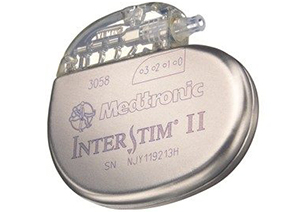
What is a Sacral Neurostimulator?
A sacral neurostimulator, commonly referred to by the popular brand name “InterStim”, is a small battery connected to a computer chips that delivers precise electrical current to nerves leaving your spinal cord, in a way that can significantly reduce or eliminate urinary urgency (the sudden and uncomfortable urge to urinate) and fecal incontinence (unexpected release of feces).
A sacral neurostimulator is considered a third line intervention for overactive bladder and can also be used to treat other conditions such as urinary retention.
Multiple types of Sacral Neurostimulators are now available, which include externally rechargeable models and MRI compatible models. Talk to your surgeon about what option is best for you.
Why might I need a Sacral Neurostimulator?
The most common reason patients select a sacral neurostimulator is for treatment of overactive bladder, with or without urinary leakage, that has not been adequately relieved by oral medications. Other reasons might include bladder pain syndrome not well treated by other technique, or fecal incontinence.
Preparing for your Sacral Neurostimulator:
In general, preparation for a sacral neurostimulator will involve the following steps:
- You will have bloodwork and other testing done at the hospital
- The hospital will call you to confirm arrival time and instructions
- You will be asked if you have allergies to medications, anesthesia, or latex.
- You should inform your doctor of any medications, vitamins, or supplements that you are taking.
- You should refrain from taking anti-inflammatories or blood-thinning medications a week prior to the procedure. Any blood thinning medications will be discussed with you and your doctors
- It is also important to inform your doctor if you are pregnant or might be pregnant, diabetic, asthmatic, or have any other medical conditions.
- You may be asked to refrain from eating 8 hours prior to your scheduled arrival time and drinking 2 hours prior to your arrival time.
- You should remove all metal objects and accessories such as eyeglasses, jewelry, watch, etc. as they can interfere with the imaging technique used.
- You should arrange for someone to drive you home after the procedure.
What happens during placement of a Sacral Neurostimulator?
Sacral neurostimulator are always performed as a two-step procedure. They can be implanted in two different ways:
Option #1 – Percutaneous Nerve Evaluations (PNE)
In the PNE approach an office-based procedure is used to place trial electrical leads. In the office your surgeon will ask you to lay on your stomach on an exam table, with your feet over the end of the table. They will clean your lower back and apply a local numbing injection. They will then use a narrow needle (similar to an acupuncture needle) to place a flexible wire alongside the S3 nerve existing your spinal cord (located in your pelvis. You will then tell the doctor what you are feeling, and based on your sensation they will adjust the wire. Once in place, this wire is connected to an external generator, which you wear on a fanny pack. Usually this remains in place for 3-5 days. While the lead is in place you record your symptoms. After the end of the trial period, you report back to your doctor and decide if you want a permanent generator.
If the trial works for you, you will then have a single surgery in which permanent leads and a generator are implanted. This takes around an hour and is done under a combination of local anesthesia and sedation.
Advantages of PNE:
- Quick test (3-5 days)
- No initial surgery
Disadvantages of PNE:
- 50% rate of lead migration causing the test to fail
- Lead placement is done without Xray, reducing accuracy
Option #2 – First stage Implantation
If you choose to have a First stage implantation, a permanent (but removable) electrical lead is placed in the operating room. This is done using Xray guidance. You will have a combination of local anesthesia and mild sedation. The lead or leads will then be connected to an external generator that you wear on a fanny pack. The trial period for the First stage implantation approach is usually two weeks. If after two weeks your symptoms have improved, you then proceed to a Second stage implantation. If they are not successful, your leads can be removed in the office.
In a Second stage implantation the existing leads are attached to a permanent generator, which is placed with a combination of local anesthesia and mild sedation. This procedure is done in an operating room and usually take half an hour.
Advantages of First stage Implantation:
- More accurate results
- If successful, 2nd procedure is much faster
Disadvantages of First stage Implantation:
- Requires two trips to the operating room
- Trial period is longer
Approximately 61% of women will have a successful trial and move on to permanent implantation.
Post-Operative Instructions
PNE
Following a percutaneous nerve evaluation you will have electrical leads coming from your low back. You should not bathe (you may clean yourself with a damp towel), or engage in activities that require significant bending, stretching, or rotation at the waist. Walking is safe, as are gentle activities. Do not engage in sexual activity during the evaluation period. The risk is movement of the lead that would decrease the quality of your test.
It is normal to have some redness at the site of placement, but your pain should be minimal. Use your provided pain medication if you have discomfort.
Do not remove the dressings.
You will complete the voiding diary to assess your response to treatment on the 3rd or 4th day of your evaluation.
First stage Implantation
Following a First stage Implantation you will have electrical leads coming from your low back. These are permanent leads, which means you can engage in all of your normal movements, although you should avoid sports, yoga, and other significant bending and stretching activities during the evaluation period.
Consider detaching your leads prior to changing clothes. Bathe yourself with a damp washcloth, do not allow your dressings to become wet.
You will complete your voiding diary to assess your response to treatment two days prior to your follow up visit.
First and Second stage Implantation, or Second stage Implantation
Following permanent implantation, you can expect mild pain and redness at the site of implantation. You can engage in gentle activity for the first two weeks, after which you should be able to resume all activity, including sex. You can shower starting two days after your surgery. You should start to see an improvement in your symptoms immediately, although some patients take several weeks and adjustment of their stimulation program to find the best settings for them. We will work with you to accomplish this.
Depending on the type of generator you chose, you can expect 3-7 years of battery life (potentially more depending on your settings and device) prior to a replacement being required.
What can I expect after my Sacral Neurostimulator?
Women who have permanent InterStim implantation average more than 50% reduction in daily incontinence episodes, and 47% are completely dry. Effects are usually noticed immediately, but if you are not getting the benefit you expected, the device can be wirelessly reprogrammed to find settings that work better for you.
What are the risks of a Sacral Neurostimulator Implantation?
The most common risk of sacral neurostimulator implantation are discomfort at the site of implantation, inflammation, and eventual depletion of the battery. Infections and lead migration requiring replacement surgery are uncommon.
